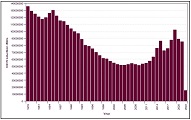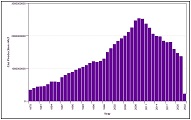Oil & Gas Resources
Oil & Gas Basins
Maps & Publications
Oil & Gas Facts
Wyoming's Oil & Gas Facts
Oil
- In 2022, Wyoming ranked eighth nationally in crude oil production.
- Wyoming produced 90.9 million barrels of crude oil in 2022, up from 85.5 million barrels in
2021.
- The Mike Murphy #1 well was the first oil well drilled in Wyoming. It was drilled in 1884
next
to a natural oil seep and was the discovery well for the Dallas field, which is still an
active
oil field today.
- Since its 1889 discovery, Salt Creek field has produced more than 737 million barrels of oil
from its estimated 1,680 million barrels of oil originally in
place.
- Quealy field was the first field in the Rocky Mountain region to be discovered using seismic
methods. The California Company used reflection seismic surveys to delineate the Quealy Dome
anticline and drilled the first productive well in Quealy field in 1934.
- The first refinery in Wyoming was built in Casper and began processing crude oil in 1895. It
had an initial capacity of 50–100 barrels of oil per day. In comparison, Casper’s modern-day
Little America refinery has a total operable capacity of 30,000 barrels per stream
day.”
- In 2022, five counties accounted for more than 80% of all oil produced in Wyoming. Those
counties are, with percent of state total, Converse County (39.4%), Campbell County (21.7%),
Laramie County (9.1%), Park County (5.3%), and Natrona County (5%).

Click the graph to view the Wyoming Oil and Gas Conservation Commission’s state oil production
Natural Gas
- In 2022, Wyoming ranked ninth nationally in natural gas production.
- Wyoming produced more than 1.29 billion Mcf (Mcf — 1,000 cubic feet) of natural gas in 2022,
down from 1.38 billion Mcf in 2021.
- Through 2022, coalbed natural gas wells in the Powder River Basin have cumulatively produced
more than 6.65 billion Mcf of gas from shallow Fort Union and Wasatch coals.
- Jonah field was discovered in 1975, but most of its development did not begin until 1992
when multi-stage hydraulic fracturing was used by the McMurry Oil Company to release the
tight gas. These, and other innovative techniques such as horizontal completions, have since
been used to exploit the tight gas and oil from Jonah field and the nearby Pinedale
anticline.
- The Rocky Mountain completion depth record was set by the Bighorn 1-5 (API 49-013-21362).
This
well was completed between 23,758 and 23,902 feet in the Madison Limestone and had an
initial
production rate of 20,000 Mcf of gas per day. The subsequent Bighorn 2-3 well (API
49-013-21510) was
completed between 23,579 and 23,852 feet in the Madison with an initial production rate of
38,000 Mcf
of gas per day. These two wells established the deepest commercial gas production in the
Rocky
Mountain region as part of the Madden field.
- The LaBarge-Shute Creek treating facility processes gas from wells within the Madison
Limestone.
This gas is rich in carbon dioxide, methane, hydrogen sulfide, and commercial quantities of
helium. Excess carbon dioxide is transported via pipeline to the Rangely field in northern
Colorado
and several fields in Wyoming for enhanced oil recovery operations.
- In 2022, five counties accounted for more than 85% of all natural gas produced in Wyoming.
Those counties are, with percent of state total, Sublette County (51.1%), Sweetwater County
(12.7%), Converse County (7.3%), Fremont County (7.0%), and Campbell County (7.0%).

Click the graph to view the Wyoming Oil and Gas Conservation Commission’s state natural gas
production
Wyoming's Oil & Gas Reserves
- Wyoming had 978 million barrels of proven oil reserves in 2021, which accounted for nearly
2.4 percent of the U.S. total reserves.
- As of 2021, Wyoming had an estimated 15,005 billion cubic feet of proven reserves of dry
natural gas, or 2.5 percent of total U.S. reserves.
Oil & Gas Prices
For information on historical, current, and future prices, please refer to the following:
Oil & Gas FAQ
- ►How do I obtain information on oil or gas wells
drilled in Wyoming?
- All oil and gas well information is maintained in a database by the Wyoming Oil and Gas
Conservation Commission (WOGCC). The database is accessible at the WOGCC website.
- ►Who regulates the oil and gas exploration and
production industry?
- Drilling and production on Wyoming State Lands and on private lands are regulated by the
WOGCC. Drilling on federal land is regulated primarily by the U.S. Bureau of Land Management or
the U.S. Forest Service.
- ►I own property in Wyoming with mineral rights. How
can I learn if oil, gas, or other minerals may be on my land?
- The WSGS is not in a position to evaluate properties. However, there are many consulting
geologists throughout the state that can help answer this question. Consulting geologists
can be found locally or often advertise in the newsletter published by the Wyoming Geological Association.
Certified professional geologists are licensed by the Wyoming Board of Professional Geologists and a
list is maintained at their website.
- ►I hear so much about “fracking” in the news but don’t
really understand what it is. Where can I find more information?
- Fracking is another term used for "hydraulic fracturing.” Hydraulic fracturing involves
pumping a mixture of water, proppant (sand or artificial material), and chemicals under very
high pressure into an oil or gas reservoir to create a network of connected fractures that
increases hydrocarbon production.
More information on hydraulic fracturing can be found on websites by the
Association of American State Geologists,
U.S. Environmental Protection Agency,
the Watershed Council,
and American Petroleum Institute.
- ►Is there a repository for cores and/or cuttings in
Wyoming?
- No. All publicly available cores and cuttings for Wyoming (as well as other states) are
stored either at the USGS Core Research Center in Lakewood, Colorado
or at the Texas Bureau of Economic Geology in multiple locations in Texas.
Contact these agencies for more information.
- ►Do you have any information on historical oil
production in Wyoming?
- WyoHistory.org
published an article on “The Oil Business in Wyoming” by Phil Roberts detailing how oil
production in Wyoming began and evolved.
The Wyoming Oil and Gas
Conservation Commission maintains scans of individual well production prior to 1978
in their database.
- ►Where can I find more information on statistics for
Wyoming’s oil and gas industry?
- Further information on oil and gas statistics, including production, prices, and more, can
be obtained from the following downloads or website:
- ►What other agencies might have useful Wyoming oil and
gas information?
-
- Wyoming Oil
and Gas Conservation Commission (WOGCC)—permits oil and gas wells and
maintains production, injection, and sales data in their database
- Department of Geology and Geophysics—University of Wyoming
- Department of Energy and Petroleum Engineering—University of
Wyoming
- Wyoming
Energy Authority—provides strategy, collaboration, and support for Wyoming’s
entire energy portfolio
- Enhanced
Oil Recovery Institute (EORI)—University of Wyoming institute that works
toward enhanced oil recovery in Wyoming oil fields
- Petroleum
Association of Wyoming (PAW)—petroleum industry trade association
- School of
Energy Resources (SER)—based at the University of Wyoming and focusing on
energy-related education, research, and outreach
- Wyoming
Bureau of Land Management (BLM)—10 field offices regulate drilling on BLM
land
- Wyoming
Department of Environmental Quality (DEQ)—works with Wyoming’s air, land,
and water resources
- Wyoming
Geological Association (WGA)—association for all geological interests, many
consulting geologists advertise through the WGA
- Wyoming
Office of State Lands and Investments—manages Wyoming State Lands, including
oil and gas leases on these lands
Contact:
Rachel Toner, rachel.toner@wyo.gov
Derek Lichtner, derek.lichtner@wyo.gov